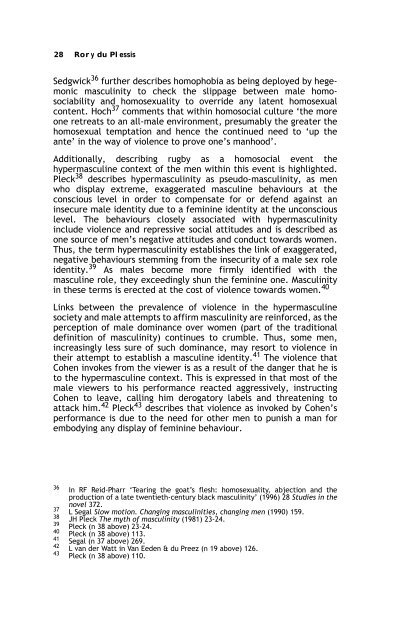Sex, Gender, Becoming - PULP
Sex, Gender, Becoming - PULP
Sex, Gender, Becoming - PULP
You also want an ePaper? Increase the reach of your titles
YUMPU automatically turns print PDFs into web optimized ePapers that Google loves.
28 Rory du Plessis<br />
Sedgwick 36 further describes homophobia as being deployed by hegemonic<br />
masculinity to check the slippage between male homosociability<br />
and homosexuality to override any latent homosexual<br />
content. Hoch 37 comments that within homosocial culture ‘the more<br />
one retreats to an all-male environment, presumably the greater the<br />
homosexual temptation and hence the continued need to ‘up the<br />
ante’ in the way of violence to prove one’s manhood’.<br />
Additionally, describing rugby as a homosocial event the<br />
hypermasculine context of the men within this event is highlighted.<br />
Pleck 38 describes hypermasculinity as pseudo-masculinity, as men<br />
who display extreme, exaggerated masculine behaviours at the<br />
conscious level in order to compensate for or defend against an<br />
insecure male identity due to a feminine identity at the unconscious<br />
level. The behaviours closely associated with hypermasculinity<br />
include violence and repressive social attitudes and is described as<br />
one source of men’s negative attitudes and conduct towards women.<br />
Thus, the term hypermasculinity establishes the link of exaggerated,<br />
negative behaviours stemming from the insecurity of a male sex role<br />
identity. 39 As males become more firmly identified with the<br />
masculine role, they exceedingly shun the feminine one. Masculinity<br />
in these terms is erected at the cost of violence towards women. 40<br />
Links between the prevalence of violence in the hypermasculine<br />
society and male attempts to affirm masculinity are reinforced, as the<br />
perception of male dominance over women (part of the traditional<br />
definition of masculinity) continues to crumble. Thus, some men,<br />
increasingly less sure of such dominance, may resort to violence in<br />
their attempt to establish a masculine identity. 41 The violence that<br />
Cohen invokes from the viewer is as a result of the danger that he is<br />
to the hypermasculine context. This is expressed in that most of the<br />
male viewers to his performance reacted aggressively, instructing<br />
Cohen to leave, calling him derogatory labels and threatening to<br />
attack him. 42 Pleck 43 describes that violence as invoked by Cohen’s<br />
performance is due to the need for other men to punish a man for<br />
embodying any display of feminine behaviour.<br />
36 In RF Reid-Pharr ‘Tearing the goat’s flesh: homosexuality, abjection and the<br />
production of a late twentieth-century black masculinity’ (1996) 28 Studies in the<br />
novel 372.<br />
37 L Segal Slow motion. Changing masculinities, changing men (1990) 159.<br />
38 JH Pleck The myth of masculinity (1981) 23-24.<br />
39<br />
Pleck (n 38 above) 23-24.<br />
40 Pleck (n 38 above) 113.<br />
41 Segal (n 37 above) 269.<br />
42<br />
L van der Watt in Van Eeden & du Preez (n 19 above) 126.<br />
43 Pleck (n 38 above) 110.
















